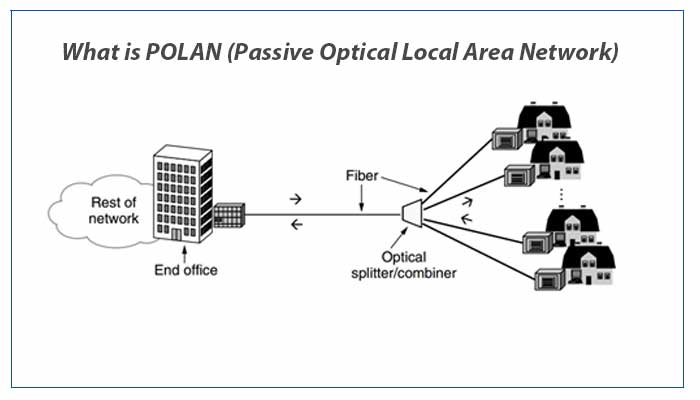In the earlier times for telecommunication or for enabling an internet connection copper wires were used. Optical Fibre, later on, replaced the copper cables due to advantages such as greater bandwidth, faster speeds, reliability, the capability to carry information over long distances etc. here maybe two ways of splitting up the data and further transmitting it; they are an active optical network and passive optical network (PON). The network setups in a LAN (Local Area Network) where PON is used may be called as a POLAN (Passive Optical Local Area Network).
Optical Fibre uses light signals for the transmission of data. In order for the data to be retrieved at the proper destination, a way is needed to separate it.
In an active optical network, electrically powered switching elements are used. These elements manage the distribution of the signal to specific customers. These switching elements work in various ways to place the incoming and outgoing signals to a proper place.
A passive optical network, on the other hand, involves no electrically powered switching elements. They instead use optical splitters to separate and collect optical signals. Since these elements don’t require power, hence the name “passive”. Such networks require power only at the source and receiving the end of the signal.
A PON system consists of optical line termination (OLT) at the communication provider’s end and a number of optical network units (ONU) at the user’s end. The term “passive” simply means that there are no power requirements while the network is up and running. A POLAN implements point-to-multipoint architecture i.e. here unpowered fibre optic splitters enable a single optical fibre to serve multiple endpoints.
Also read…
- What is Campus Area Network(CAN) and How does it Work
- What is Desk Area Network and How Does it Work
An OLT is a device which serves as the service provider’s endpoint of a POLAN. An OLT performs a conversion between electrical signals used by the service provider’s equipment and the fibre optical signals used by the passive optical network. An ONU is situated at the customer’s end. It is a device which transforms incoming optical signals to electronic signals.

The following figure further clarifies this arrangement. In this figure, the signals sent from the Central office to the ONUs, i.e. the downstream signals are broadcasted to all ends using the optical fibre. The signal from the multiple ONUs to the OLT i.e. the upstream signals are combined using multiple access protocols such as the TDMA, which has been explained below.
TDMA is a method which allows multiple stations to access a channel or a medium without causing each station’s signal interference into other signals. This is achieved by dividing signals into different time slots. Each station transmits in rapid succession and each one is allotted its own time slot. In this way, multiple stations may share the same channel but use only a part of its capacity.
A passive optical network can be of three types:
- FTTC (Fibre to the curb). It is designed as the replacement for old telephone service. Optical fibre is used up to the curb to the building. Then a coaxial or twisted-pair copper wire carries the signals to the short distance up to the building or home.
- FTTB (Fibre to the building). In this, the optical fibre goes to a certain point on a shared property. From this common point, other cables provide the connection to individual homes or offices.
- FTTH (fibre to the home). Here the optical fibre connection is direct to the user’s home or office. While in the above mention two types, fibres reach till a certain point and then connections are made using traditional cables. FTTH gives better performance and speed compared to the other two.
Advantages of a POLAN
- Efficiency is good as each optical fibre strand can serve up to 32 users
- Lower maintenance and setup costs than Active optical networks.
- Lesser moving or electrical parts in a POLAN makes it less vulnerable to faults.
- Since an Active optical network requires power, it is intrinsically less reliable than a POLAN
- As compared to point-to-point architecture, a POLAN reduces the amount of fibre and central office equipment required.
Disadvantages of a POLAN
- Isolation of failures is a difficult thing in a POLAN to do.
- They have a lesser range than an Active Optical Network; hence subscribers need to be located nearer to the central source of data than an AON.
- In a POLAN bandwidth may not be dedicated to individual subscribers and hence data speed may slow down during the peak time usage. This is due to latency or the delay in the relay of data.
Download What is POLAN (Passive Optical Local Area Network) in pdf – Click here

